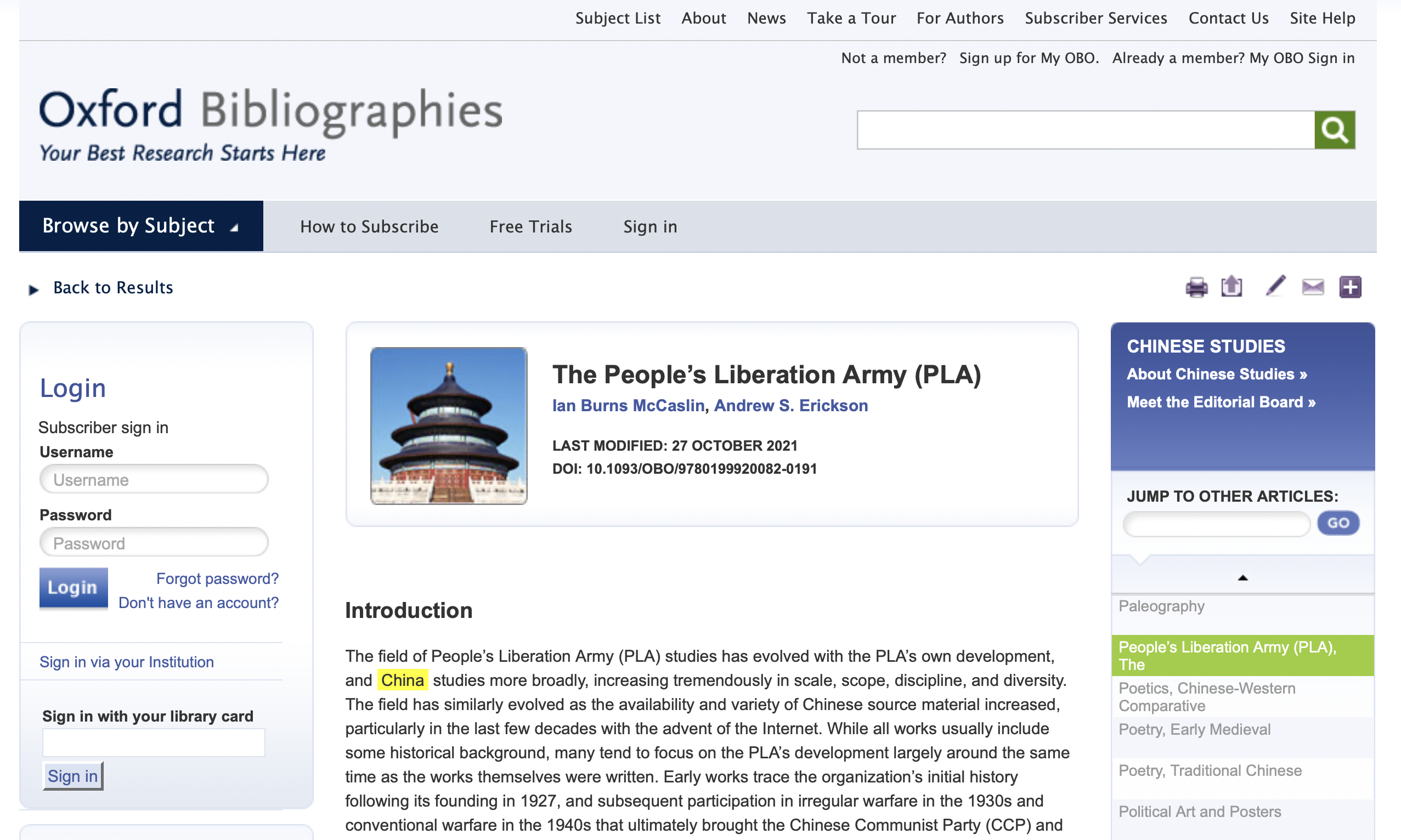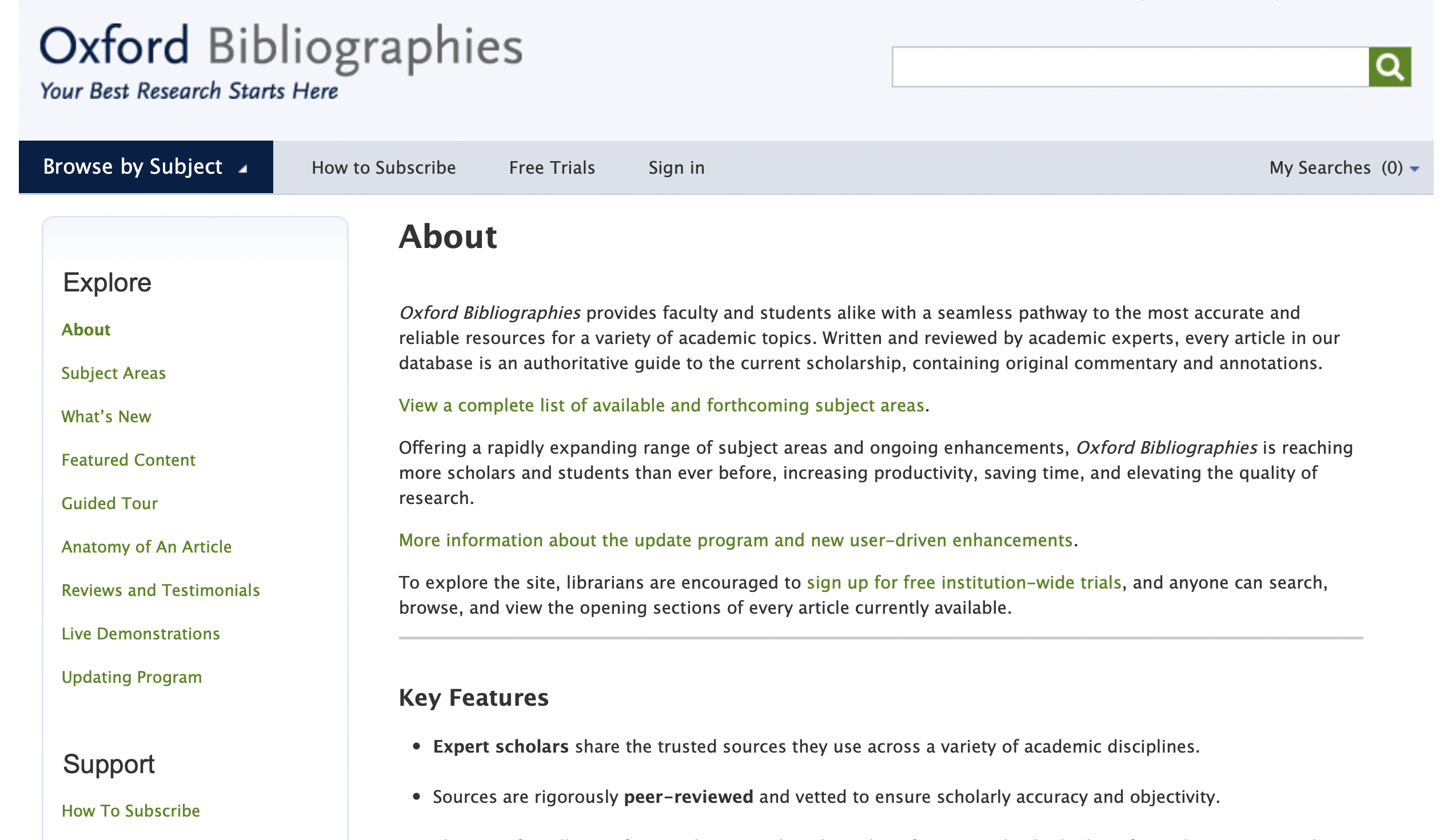New Oxford Bibliography: “The People’s Liberation Army (PLA)”
Honored to publish Oxford University Press’s Oxford Bibliography on “The People’s Liberation Army (PLA)” with Ian Burns McCaslin! 74 pages of entries cover leading works in the field, each with a convenient summary. When we started compiling this 3+ years ago, we wondered why there weren’t more such resources… We learned the hard way—and want to share the results with you. Special thanks to the late Professor Ezra Vogel for his mentoring and support, and to several dozen leading scholars and analysts in the field for their invaluable inputs! We hope this new source can further assist & encourage the study of China and its armed forces.
Ian Burns McCaslin and Andrew S. Erickson, “The People’s Liberation Army (PLA),” Oxford Bibliography (Oxford, UK: Oxford University Press, 27 October 2021).
- Featured in Chinese Military History Society Newsletter, Number 42, June 2022.
Introduction
The field of People’s Liberation Army (PLA) studies has evolved with the PLA’s own development, and China studies more broadly, increasing tremendously in scale, scope, discipline, and diversity. The field has similarly evolved as the availability and variety of Chinese source material increased, particularly in the last few decades with the advent of the Internet. While all works usually include some historical background, many tend to focus on the PLA’s development largely around the same time as the works themselves were written. Early works trace the organization’s initial history following its founding in 1927, and subsequent participation in irregular warfare in the 1930s and conventional warfare in the 1940s that ultimately brought the Chinese Communist Party (CCP) and its Army to power in 1949. The next several decades of PLA studies focused on organizational development and the PLA’s involvement in politics and policy as it transitioned from being a nonstate revolutionary military to one functioning within the role of a military force both of a political party and vis-à-vis the country that party ruled. These earlier phases of PLA studies were marked by limited access to Chinese sources, as well as archival material from countries that interacted with China, especially during the Cold War. Such seminal figures in the field as Ellis Joffe warned their readers that the insufficient source material available to them limited analysis. With the end of the Cold War, the opening up of more Chinese and foreign archives, and the proliferation of personal Chinese accounts and Internet resources, a new era in the field of PLA studies began in the 1990s. The increased accessibility and multiplicity of sources gave the field a breadth and depth of perspective long obscured by PRC censorship. The burst of activity that came from the PLA during this time to strengthen its capabilities similarly gave the field more data with which to work. The development of China’s media and information market, as well as the efforts from the central leadership and increasingly competitive services and branches of the PLA to showcase their capabilities to their fellow citizens and the world, have similarly resulted in an expansion of sources and data in the years since. However, despite their age, many older works retain great value. Not only do they show the different strands of thought that existed within the field at different periods of time, but they also contain some older sources otherwise unavailable, such as interviews and personal interactions with important actors who have since passed away, or even quotes from documents that have not yet been digitized. The laborious linguistic demands and other analytical challenges associated with this field incentivize collaboration. Many leading works are edited volumes based on conference proceedings. The views expressed here are the authors’ alone. They are grateful for inputs from several dozen leading scholars and analysts in the field. They dedicate this bibliography to the memory of Ezra Vogel (1930–2020) in appreciation of his generous mentoring and support. Since this is a bibliography of the field of PLA studies, we do not include official PRC documents because they are not in the field itself but rather its subject. Space constraints likewise prevent us from including most reports from other nations’ governments.
Historical and Field Overviews and Methodology
A lack of survey works has long left too much of PLA studies an artisanal hodgepodge for generalists and specialists alike. This is compounded by the fact that few PLA experts teach at civilian universities; young aspirants attempting to enter the PLA studies field, including one of the authors, often have to learn through self-guidance and by reading whatever works they are able to get their hands on. The demographics of those who participate in the PLA studies field have also been changing with the times. In previous decades, many of the leading experts were either generalist China scholars or former US military attachés who served in China during their later years in uniform. Today, many of the younger members of the field work in academia, think tanks, and consultancies. Their careers and contributions reflect a relentless trend of professional specialization. Many have studied in China more extensively than their predecessors, have a greater level of fluency in Mandarin Chinese, and employ more diverse, complex, technology-augmented methodologies. For many members of the younger generation of experts, experience with the military comes through research or contracting work, rather than uniformed service. Early researchers typically lacked the ability to enter the PRC, those in recent decades enjoyed significant direct access, and now PRC security restrictions and related concerns may be narrowing in-country access once again. What impact these generational career differences have on the output of the field remains to be seen. Until recently, contributors’ knowledge bases have thus depended on what they are able to locate and consume. Following the foundational Allen 2021, the pioneering Mattis 2015a and Mattis 2015b are geared toward newcomers to the field, as is American Mandarin Society 2019. Surveys of the field of PLA studies itself have been rare. Two of the most notable are Mulvenon and Yang 2001, which focuses on trends in the 1980s and 1990s, and Ash, et al. 2007, which examines the differences within the field across several countries and regions. Given the difficulty of writing an effective history of the PLA for newcomers or outsiders, few works have attempted such an ambitious task; however, some, such as Li 2007, have managed to do so. Joffe 1987 traces the PLA’s recovery from Maoist diversion. Finally, with the growing diversity of source material available to the field, notably from archives in China, Kraus 2016 provides a guide for those looking to utilize such material for further historical research. Fanell and Martinson 2016 and Martinson 2016 address open source research methodology.
Allen, Kenneth W. “Survey of English-Language Books on the PLA.” China Analysis from Original Sources, 1 March 2021.
- This foundational survey of modern PLA studies reveals the state of the field just before the two decades’ meteoric growth to its present profusion. It specifically covers five dozen of the most significant works published over the past three decades, together with other sources emerging from China’s government and in then-still-new media such as the Internet. This history remains significant; it reflects the context in which the PLA itself has modernized.
American Mandarin Society. Self-Study Syllabus on the Chinese People’s Liberation Army. Washington, DC: American Mandarin Society, 2019.
- As part of its syllabi project, the American Mandarin Society offers periodically updated self-study outlines, including one devoted to the PLA. This syllabus is divided into different subjects related to the PLA and is designed to be read in one-hour increments (about 40–50 pages per night) for five nights a week for four weeks.
Ash, Robert, David Shambaugh, and Seiichiro Takagi, eds. China Watching: Perspectives from Europe, Japan and the United States. New York: Routledge, 2007.
- This work contains three chapters on the study of China’s foreign and security policies in Europe, Japan, and the United States. While not focusing exclusively on the PLA, they provide rare perspectives regarding the differences between the PLA studies field in different countries and regions, which persist despite greater access to media and academic journals online. The amount of interaction among these communities is often surprisingly limited.
Fanell, James E., and Ryan D. Martinson. “Countering Chinese Expansion through Mass Enlightenment.” Washington, DC: Center for International Maritime Security (CIMSEC), 18 October 2016.
- There is much that US Navy intelligence can and should do to provide the raw materials needed for open source researchers to more fully grasp the nature of China’s nautical ambitions. Sharing information about the movements and activities of Chinese forces could be done without compromising the secrecy of the sources and methods used to collect it. Doing so would improve the quality of scholarship and elevate the public debate.
Joffe, Ellis, The Chinese Army after Mao. Cambridge, MA: Harvard University Press, 1987.
- Analyzes the recovery of the PLA from the turbulent later years of Mao’s rule, which saw “its decline as a professional force,” and the subsequent strides it made on path toward modernization and toward a more specialist mindset.
Kraus, Charles. “Researching the History of the People’s Republic of China.” Cold War International History Project Working Paper 79. Washington, DC: Woodrow Wilson International Center for Scholars, April 2016.
- Provides a guide for those looking to conduct archival research in China, with a special eye toward “the actual situations on the ground,” given the disparity between what is legally allowed and what is actually allowed to happen with such work. In addition to providing advice on navigating bureaucratic hurdles and other characteristics of Chinese archives, it also highlights the value of tapping archives and discusses archive-specific opportunities.
Li, Xiaobing. A History of the Modern Chinese Army. Lexington: University Press of Kentucky, 2007.
- This work details the history of the PLA from 1949 to 2002. Perhaps its most valuable aspect is the detailing of personal histories of PLA soldiers and officers, as well as some relevant civilians. While some works have focused on the personal histories of high-profile individuals involved with the PLA, this work includes the personal histories of less-well-known individuals to showcase the changing force.
Martinson, Ryan D. “The Scholar as Portent of Chinese Actions in the South China Sea.” Washington, DC: Center for International Maritime Security (CIMSEC), 25 July 2016.
- Argues for importance of distinguishing advisors from propagandists, both of whom have direct connections with the party-state. Studying the work of the propagandist has merits: we learn what the PRC wants domestic and international audiences to believe. The statements of the advisor, however, are potentially much more rewarding, for they may suggest future actions. Knowing what Beijing may do allows one to engage in proactive diplomacy and prepare countermeasures.
Mattis, Peter. Analyzing the Chinese Military: A Review Essay and Resource Guide on the People’s Liberation Army. Charleston, SC: Create Space, 26 May 2015a.
- A valuable compendium that provides helpful advice and guidance on everything from interpreting sources, to the relationship between the PLA and the CCP, to PLA expert conferences.
Mattis, Peter. “So You Want to Be a PLA Expert?” War on the Rocks, 2 June 2015b.
- A short encapsulation of Mattis 2015a, a landmark guide to the PLA studies field.
Mulvenon, James C., and Andrew N. D. Yang, eds. Seeking Truth from Facts: A Retrospective on Chinese Military Studies in the Post-Mao Era. Santa Monica, CA: RAND Corporation, 2001.







































